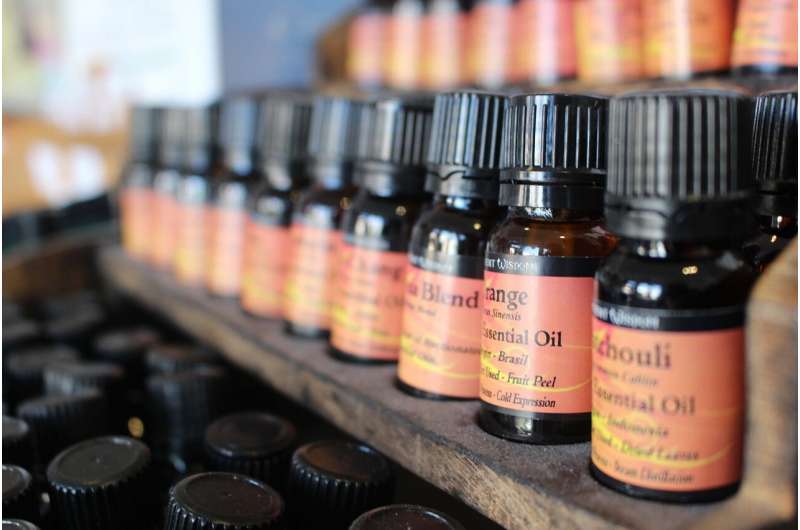This article has been reviewed according to Science X's editorial process and policies. Editors have highlighted the following attributes while ensuring the content's credibility:
fact-checked
proofread
Researchers explore the molecular mechanisms and therapeutic potentials of essential oils

Essential oils, also known as ethereal oils, are volatile, aromatic compounds derived from plants. Found in only about 10% of the plant kingdom, these oils are present in secretory structures such as glands, ducts, cavities, and hairs. Chemically, they belong to categories such as terpenes, phenols, and nitrogen-bearing compounds, consisting of carbon, hydrogen, and other elements like oxygen, nitrogen, and sulfur.
Essential oils are valuable secondary metabolites with significant bioactive components, offering a range of therapeutic potentials. They play a protective role in plants against pathogens and have been used traditionally in various remedies for mental health and chronic diseases due to their rapid tissue penetration and broad spectrum of biological activities.
The composition of essential oils varies greatly depending on the plant species, geographic location, and extraction method. The primary methods of extraction include steam distillation, solvent extraction, cold pressing, and supercritical fluid extraction.
These methods influence the yield and purity of the essential oils, which in turn affects their therapeutic efficacy. The major components of essential oils, such as monoterpenes, sesquiterpenes, and their oxygenated derivatives, determine their biological activities.
Recent studies have highlighted the diverse biological activities of essential oils, including their antimicrobial, antiviral, anthelminthic, antioxidant, antiulcer, anti-inflammatory, insecticidal, larvicidal, and immunomodulatory effects. These properties make essential oils valuable in various industries, such as food, cosmetics, and pharmaceuticals. The therapeutic effects of essential oils are mediated through several biological mechanisms, including their antioxidative, antimicrobial, anticarcinogenic, anti-diabetic, and anti-inflammatory properties.
Free radicals are responsible for oxidative stress, leading to lipid peroxidation and cellular damage, which can result in diseases like cancer, Alzheimer's, atherosclerosis, and Parkinson's disease. Essential oils demonstrate significant antioxidant activities by donating hydrogen or electrons to neutralize free radicals, thereby preventing oxidative stress and protecting cellular components.
The antioxidant potential of essential oils is often evaluated using in vitro methods like the Diphenylpicrylhydrazyl (DPPH) assay, which measures their free radical scavenging ability. In vivo assessments involve measuring levels of endogenous antioxidants like reduced glutathione, superoxide dismutase, and catalase, alongside nitric oxide levels. Essential oils enhance these antioxidant defenses, thus mitigating oxidative damage.
Essential oils exhibit potent antimicrobial properties, effective against a wide range of microorganisms. The antimicrobial mechanism involves disrupting microbial cell membranes, inhibiting enzyme activity, and interfering with microbial metabolism. These properties make essential oils suitable for applications in food preservation, medicine, and hygiene products. Notably, essential oils can disrupt the biofilms formed by bacteria, making them effective even against antibiotic-resistant strains.
The anticarcinogenic properties of essential oils are attributed to their ability to induce apoptosis (programmed cell death) and inhibit cancer cell proliferation. Essential oils achieve this by modulating signaling pathways involved in cell growth and survival, enhancing the activity of detoxifying enzymes like glutathione S-transferase, and promoting the degradation of carcinogens. This makes essential oils promising agents in cancer prevention and therapy. Some essential oils have shown the ability to inhibit angiogenesis (the formation of new blood vessels), which is critical for tumor growth and metastasis.
Essential oils also show potential in managing diabetes by modulating glucose metabolism and improving insulin sensitivity. They enhance the activity of glucose transporter proteins, reduce oxidative stress in pancreatic β-cells, and inhibit enzymes involved in carbohydrate digestion. These effects contribute to better glycemic control and reduced complications associated with diabetes. Essential oils like cinnamon and clove have shown promise in lowering blood glucose levels and improving lipid profiles in diabetic models.
Inflammation is a critical response to injury and infection but can lead to chronic diseases if unregulated. Essential oils exhibit anti-inflammatory properties by inhibiting the production of pro-inflammatory mediators like cytokines and prostaglandins. They also modulate the activity of enzymes such as cyclooxygenase and lipoxygenase, reducing inflammation and associated tissue damage. The anti-inflammatory effects of essential oils are beneficial in managing conditions like arthritis, inflammatory bowel disease, and other chronic inflammatory disorders.
The therapeutic applications of essential oils are vast, encompassing aromatherapy, topical applications, and oral formulations. In aromatherapy, essential oils are used to promote mental and emotional well-being. Topical applications leverage their antimicrobial and anti-inflammatory properties to treat skin conditions, wounds, and infections.
Oral formulations are explored for their systemic effects, including anti-diabetic, anticarcinogenic, and antioxidant benefits. The versatility of essential oils makes them suitable for integrative medicine, combining traditional practices with modern therapeutic strategies.
Despite the promising therapeutic potentials of essential oils, several challenges need to be addressed. The variability in composition due to different extraction methods and plant sources can affect the consistency and efficacy of essential oils. Standardization and quality control are essential to ensure the therapeutic effectiveness of essential oils.
Moreover, extensive research is needed to fully elucidate the molecular mechanisms underlying their biological activities. Future studies should focus on identifying the active compounds in essential oils, understanding their interactions at the molecular level, and exploring their synergistic effects.
Essential oils, with their diverse therapeutic potentials, offer promising avenues for treating various health conditions. Their antioxidative, antimicrobial, anticarcinogenic, anti-diabetic, and anti-inflammatory properties are mediated through complex molecular mechanisms at the cellular level.
Despite significant progress in understanding these mechanisms, comprehensive research is still needed to fully elucidate the fundamental actions of essential oils. Future studies leveraging systems biology approaches will be crucial in uncovering the intricate interactions and effects of essential oils within biological systems, ultimately enhancing their application in integrative medicine.
The work is published in the journal Future Integrative Medicine.
More information: Rakesh Kashyap, Exploring the Molecular Mechanisms and Therapeutic Potentials of Essential Oils: A Systems Biology Approach, Future Integrative Medicine (2024). DOI: 10.14218/FIM.2023.00071
Provided by Xia & He Publishing Inc.





















